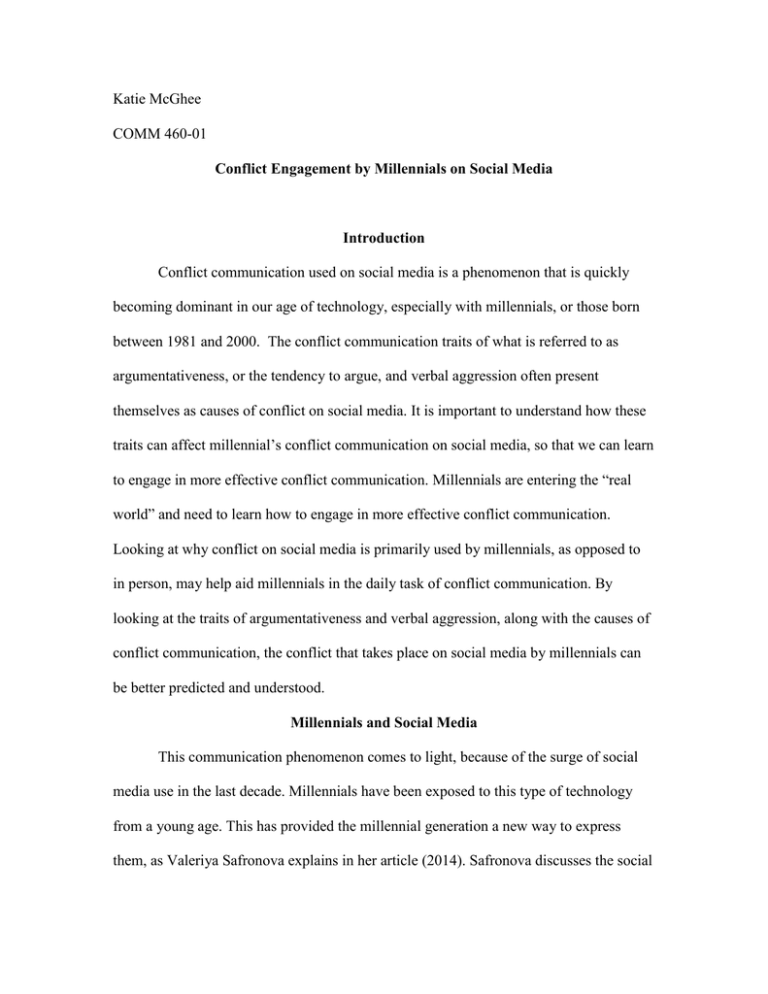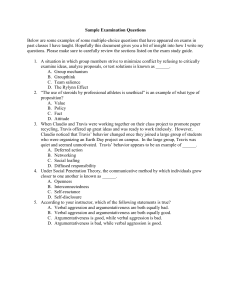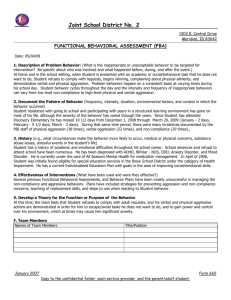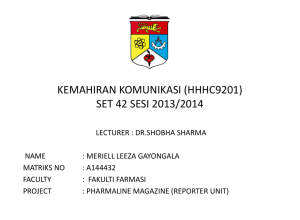- Longwood Blogs
advertisement

Katie McGhee COMM 460-01 Conflict Engagement by Millennials on Social Media Introduction Conflict communication used on social media is a phenomenon that is quickly becoming dominant in our age of technology, especially with millennials, or those born between 1981 and 2000. The conflict communication traits of what is referred to as argumentativeness, or the tendency to argue, and verbal aggression often present themselves as causes of conflict on social media. It is important to understand how these traits can affect millennial’s conflict communication on social media, so that we can learn to engage in more effective conflict communication. Millennials are entering the “real world” and need to learn how to engage in more effective conflict communication. Looking at why conflict on social media is primarily used by millennials, as opposed to in person, may help aid millennials in the daily task of conflict communication. By looking at the traits of argumentativeness and verbal aggression, along with the causes of conflict communication, the conflict that takes place on social media by millennials can be better predicted and understood. Millennials and Social Media This communication phenomenon comes to light, because of the surge of social media use in the last decade. Millennials have been exposed to this type of technology from a young age. This has provided the millennial generation a new way to express them, as Valeriya Safronova explains in her article (2014). Safronova discusses the social media platform, Tumblr, and quotes Zellie Thomas, a popular social activism blogger, wo claims of millennials that, “Now, with social media, they feel empowered, like people are hearing their voice. And Tumblr is a great platform for all types of media.” Using social media as an outlet for frustrations, or other emotions, does not just occur on Tumblr. By scrolling through Facebook, Twitter, or Instagram it can be seen that many millennials voice their opinions, beliefs, and concerns on social media. This is where the phenomenon of conflict communication comes in. Millennials use social media as a means of confrontation to avoid issues face-to-face interactions. This becomes an issue when it begins to affect their personal and professional lives. Merav Gur (2014) notes that millennial women tend to turn toward avoidance in face-to-face conflicts for fear of leaving their comfort zone. This fear of conflict is leading to a lack of intimate relationships for millennial women, thus hindering their personal relationships. Rek Huppke notes that millennials, “seem to have a problem with personal interaction and conflict resolution” (2012). After speaking with psychologist Dr. Linda Gravett, Huppke explains that millennials are lacking necessary confrontational skills needed in a professional setting. After asking millennials why they do not simply ask another individual to coffee to discuss a conflict, she claims many regarded that as “too personal.” This lack of face-to-face conflict communication can be detrimental to learning how to handle conflict and confrontation in person. It can also cause the traits of argumentativeness and verbal aggression to be displayed by social media users. The purpose of this study will be to identify causes of the conflict communication traits of verbal aggression and argumentativeness for millennials on social media. Theoretical Grounding Social Information Processing Theory, by Walther, explains how people get to know one another when online and without the help of nonverbal cues. Walther (1992) discusses how people develop and maintain relationships in an online world. As it relates to my topic, there are two main constructs that can help explain how millennials use social media. The concept of translation of cues is an important construct to this theory, as it explains that language can take the place of nonverbal cues and still be effective in an online relationship. For example, using “caps lock” in place of yelling can be considered a translation of verbally aggressive cues. Another key construct is rate, which describes the effect that a slower rate of communication through online communication can have on developing a relationship online. The Since messages online do not take place in real time, it can take longer to develop relational communication, and therefore personal relationships. Therefore an argument, or conflict, through social media can take place over a span of days, weeks, or months and generates more organic responses, as opposed to a face-to-face argument that cannot rely on the time away from social media used to respond. Conflict Reasoning and Causes Conflict communication can involve a variety of factors, from the traits of argumentativeness and verbal aggression to avoiding a conflict altogether. Argumentativeness and verbal aggression have the ability to influence how an individual responds to conflict situations. The causes of conflicts can also provide background as to why or how someone responds to conflict or confrontation. Confrontation may have become an issue depending on an individual’s background and it may go beyond the traits of verbal aggression and argumentativeness. Avoidance as a strategy of conflict communication is commonly used by millennials, as well, and is important to the understanding of conflict communication. This section will explore the 5 areas related areas of research proven to be significant to this issue: Argumentativeness, verbal aggression, confrontation, causes of conflict and avoidance. Argumentativeness Miller & Roloff (2014) sought to understand whether the trait of argumentativeness was involved in engaging in conflict or ending conflict between romantic partners. It was found that argumentativeness is positively related with the “willingness to confront a partner regardless of the personal attack type” (Miller & Roloff, 2014). This suggests that when presented with confrontation, people who enjoy arguing are prone to approach their partner, engaging in conflict, rather than avoid them after hurtful comments have been made. Meluch & Walter (2012) discuss argumentativeness in relation to computer-mediated communication (CMC) and face-toface (FTF) communication. It was found that, the trait of argumentativeness, or the tendency to argue, was expressed regardless of the context used (FTF or CMC). However, the results show that CMC has a higher average score of argumentativeness. The authors state that, though “this is not statistically significant, we have reason to believe that future studies may indicate that an individual is more likely to be argumentative while in engaging in conflict online than when in FTF interactions” (Meluch & Walter, 2012). In conclusion, the trait argumentativeness can be significant when engaging in conflict and confrontation. Though the results of Meluch & Walter (2012) show that argumentativeness does not change across contexts, it can play a role in the frequency of conflict taking place on social media. Verbal Aggression Aloia & Solomon (2013) investigates the association between familial history exposure to verbal aggression and the tendency to be verbally aggressive in romantic relationships by surveying college-aged students. The finding suggests that individuals who have been exposed to verbal aggression as a child may become more accustom to those experiences by my not viewing them as problematic (Aloia & Solomon, 2013). The authors’ research explains that exposure to verbal aggression can desensitize cues that are used to “trigger empathic responding by undermining the development of emotion regulation skills,” (Aloia & Solomon, 2013) thus causing individuals to not respond normally to conflict situations. Croucher et al. (2012) discusses how the demographics of sex, education, religion, and religiosity influence the relationship between argumentativeness and verbal aggression based on surveys given to people aged 18-78. Religiosity refers to the different aspects of religious dedication and belief. Researchers found that all of the variables can influence verbal aggression, whether it increases it or decreases it. Males were found to be highly more verbally aggressive than females, and that “women who were more likely to stereotype men as argumentative, were also likely to stereotype men as aggressive” (Croucher et al, 2012). However, the traits of verbal aggression and argumentativeness do not appear to be related. In conclusion, background demographics and exposure to verbal aggression can affect an individual’s likelihood to be verbally aggressive in conflict. Confrontation Meluch & Walters (2012) found that confrontational strategies do not seem to change depending on the context. This can be related to their findings that an individual’s willingness to argue does not change based on context (CMC or FTF). Nevell & Stutman (1983) examined social confrontation as a problematic situation and how it affects people by having undergraduates role-play confrontation situations. This study found from the six role-playing situations displaying social confrontation that, depending on who the confrontation is between, there are different expectations. Negotiating and establishing social rules in a social confrontation is necessary to resolving confrontation (Nevell & Stutman, 1983, p. 733). Nevell & Stutman (1983) explain that, “how confrontation is initiated may reflect the confidence of the confronter in the legitimacy, or shared understanding, of the rule, and thus influence the entire process of the confrontation encounter.” In conclusion, confrontation can be a type of conflict communication that depends entirely on the background of the individual engaging in conflict. Causes of Conflict Miller & Roloff (2014) suggest that insults instigated by a romantic partner can cause an individual to engage in conflict communication. The researchers explain that an argumentative individual confronts their partner primarily for utilitarian reasons, “such as refuting the attack, reducing their stress, and/or changing their partner’s view of them” (Miller & Roloff, 2014). Meluch & Walters (2012) found that in computer-mediated communication; miscommunication can often be a cause of conflict and lead to further misunderstandings (p. 36). The researchers suggest that this could be because there is a lack of immediacy in CMC, as opposed to FTF interactions. In FTF interactions, there is a perception that there may be more at stake because of this immediacy. It can cause participants to be more involved (Meluch & Walters, 2012). Avoidance Wang, Fink, and Cai (2012) create a typology, or classification system, encompassing different conflict goals to demonstrate how avoidance is a conflict strategy based on questionnaires from students ranging from ages 17-25. The results of this study find that the typology created help predict the avoidance and non-avoidance strategies used in conflict and the conflict goals used. These conflict goals are competitive goals and cooperative goals, and either may become the most important depending on the conflict situation. Competitive goals become most important when there is a perceived incompatibility that is stronger than a mutual dependence. When interdependence is more important then cooperative goals become the most important (Wang et al, 2012). Conflict goals successfully predict avoidance strategies used in conflict and help show that these strategies are of importance to conflict communication. Wang et al (2012) found that avoidance in a conflict does not necessarily mean that an individual has a low concern for the situation. Methodology This study will be conducted with quantitative methodology. The frequency, or rate, of the conflict communication will be a main focus and what is measured. In addition, the causes of the communication phenomenon are a primary interest of the study. This approach will help predict particular outcomes involved with engaging in conflict communication on social media. Many previous studies have used quantitative methodologies to analyze this phenomenon, therefore this approach is effective in understanding certain gaps associated with conflict communication. A quantitative approach is better to gage the frequency of this particular communication experience and therefore the causes of it. H1: A higher family history of verbal aggression and argumentativeness in millennials will cause there to be a higher frequency of conflict on social media. This hypothesis will fill a research gap by showing how the conflict traits of verbal aggression and argumentativeness affect millennials’ approach to conflict on social media. It will show the willingness of millennials to argue based on their background. H2: A more verbally aggressive or argumentative millennial will be engaged in more conflict on social media. This hypothesis will display how these conflict traits affect the amount of conflict a person is engaged in. It is not known if these two traits make an individual involved in more conflict than someone who does not display these traits. Participants Millennials, or those born between 1981 and 2000, are the specific group to be studied, because they are a majority of the people who use social media as a means of communication. Different social media sites will be examined, such as Facebook, Twitter, Tumblr, and Instagram, for this study in order to analyze the different contexts versus face-to-face conflict. By looking at participants’ experiences, certain communicative behaviors, such as verbal aggression and argumentativeness, can be understood when they are present in conflict on social media. The frequency of which this phenomenon occurs and how it is related to people who display verbal aggression and argumentativeness will be the focus of the study. The traits of verbal aggression and argumentativeness are important to know and understand before beginning research. Past studies will be useful in identifying and recognizing when these traits are being displayed in conflict situations. Recognizing the different nonverbal cues that do not translate the same over computer-mediated communication will also be necessary for recognizing verbal aggression and argumentativeness. Procedure Participants will be asked to take a survey with questions relating to the areas of verbal aggression, argumentativeness, avoidance, confrontation, and causes of conflict. More specifically, the surveys will focus on family history, the frequency of confrontational occurrences on social media, and the context (FTF or CMC) of which conflicts take place on. One independent variable that would be studied is the conflict trait of verbal aggression. Verbal aggression is identified as the tendency to criticize the self-concepts of an individual along with their opinions or ideas of certain topics (Aloia & Solomon, 2013). Other researchers have found relationships between verbal aggression and romantic relationships and between verbal aggression and family background. However, there has not been research done to uncover the relationship between verbal aggression and social media. The dependent variable will be the confrontation on social media as a result of verbal aggression. The ANOVA test will be used to test these variables. An ANOVA test is an analysis of variance that will determine the different levels of the independent variable (N. Johnson, personal communication). The independent variable would be verbal aggression and the 3+ groups of this independent variable would be high verbal aggression, moderate verbal aggression, and low verbal aggression. These levels were chosen, because they can help explain how much verbal aggression can lead to conflict on social media. An individual who is moderately verbally aggressive may engage in less conflict on social media than one who is highly verbally aggressive. According to our class slides, surveys help “Identity self-reported behaviors and practices and identify attitudes/beliefs” (N. Johnson, personal communication). This definition explains what will be done with the survey for this particular study. The survey will be distributed to a sample of Longwood University students aged 18-25. A few examples of conflict, verbal aggression, and argumentativeness on social media will be provided for context. Participants will be asked questions about their background with verbal aggression and argumentativeness. Verbal aggression, argumentativeness, and avoidance of confrontation will be the general topic areas discussed in this survey Conclusion Although the traits of argumentativeness and verbal aggression have been discussed—in terms of what influences them, whether they affect conflict, and whether they are more present in computer-mediated communication—more research needs to be done on how these traits influence conflict communication for millennials on social media. Many of these studies used participants in the same age range as millennials, which will aid in the research. By understanding how millennials are influenced by argumentativeness and verbal aggression in conflict, the causes of conflict communication on social media may become clearer. References Aloia, L. S., & Solomon, D. H. (2013). Perceptions of verbal aggression in romantic relationships: The role of family history and motivational systems. Western Journal Of Communication, 77(4), 411-423. doi:10.1080/10570314.2013.776098 Croucher, S. M., Holody, K., Anarbaeva, S., Braziunaite, R., Garcia-Michael, V., Yoon, K., Oomen, D. & Spencer, A. (2012). Religion and the relationship between verbal aggressiveness and argumentativeness. Atlantic Journal Of Communication, 20(2), 116-129. doi:10.1080/15456870.2012.665347 Gur, M. (2014, March 25). Millennials and failed intimate relationships. Retrieved from http://www.huffingtonpost.com Huppke, R. (2012). Millennials struggle with confrontation in the workplace. Retrieved from http://articles.chicagotribune.com Meluch, A. L., & Walter, H. L. (2012). Conflict management styles and argumentativeness: Examining the differences between face-to-face and computer-mediated communication. Ohio Communication Journal, (50), 31-47. Miller, C. W., & Roloff, M. E. (2014). Argumentativeness and hurtful message type: Their relationship with confrontation and pressure to end conflicts. Communication Research Reports, 31(1), 1-13. doi:10.1080/08824096.2014.866428 Nevell, S. E., & Stutman, R. K. (1983). Interpersonal disagreement: The study of social confrontation. Conference Proceedings -- National Communication Association/American Forensic Association (Alta Conference On Argumentation), 725-739. Safronova, V. (2014, December 20). Millennials and the age of tumblr activism. Retrieved from http://www.nytimes.com. Walther J. B. (1992). ISocial information processing theory: Impressions and relationship development online. In Braithwaite D. O. & Schrodt P. (Eds.), Engaging theories in interpersonal communication: Multiple perspectives (pp. 417-426). Los Angeles, California: SAGE Publications. Wang, Q., Fink, E. L., & Cai, D. A. (2012). The Effect of Conflict Goals on Avoidance Strategies: What Does Not Communicating Communicate?. Human Communication Research,38(2), 222-252. doi:10.1111/j.1468-2958.2011.01421.x Appendix A Survey question example: 1. How often were you exposed to verbal aggression as a child? Very often Fairly often Occasionally Rarely Never Two survey questions that stem from this dependent variable are: 1. How often do you engage in conflict on social media? Very Often Fairly Often Occasionally Rarely Never This will help me operationalize the DV, because it will show whether the participant engages in conflict often on social media. It will follow the questions about verbal aggression and help show if there is a relationship between the IV and DV. 2. Do you think computer-mediated confrontation is more effective than face-to-face confrontation? Completely agree Generally Agree Unsure Generally Agree Completely Disagree This question will operationalize the DV, because it will show whether the participant believes CMC is more effective in confrontation. It will also show whether or not verbally aggressive individuals would rather engage in confrontation online or in person.







